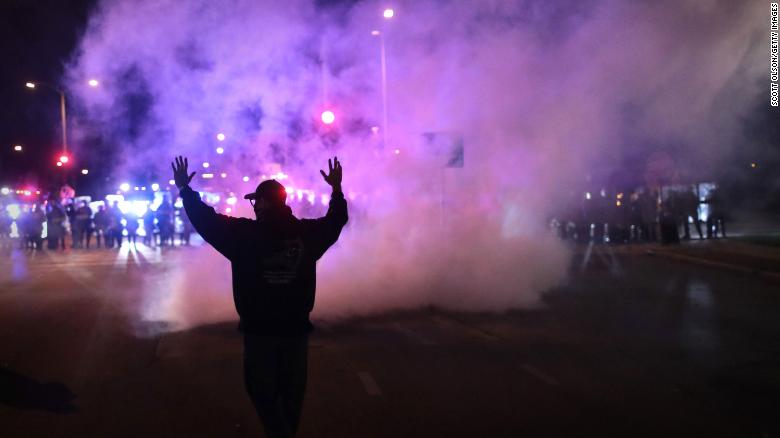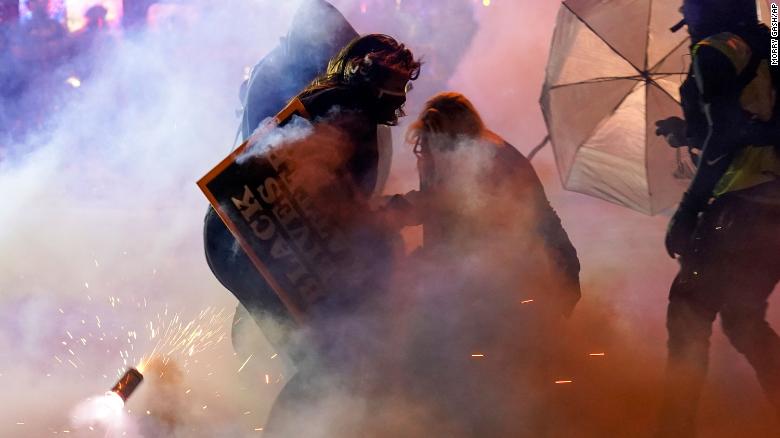Wisconsin police deploy tear gas as protests over Alvin Cole's death move into third night
By Amir Vera and Raja Razek, CNN
Updated 1:37 AM ET, Sat October 10, 2020

Protestors demonstrate near the Wauwatosa City Hall on Friday in Wauwatosa, Wisconsin.
(CNN)Tensions escalated for a third night in Wauwatosa, Wisconsin, as police used tear gas on demonstrators, who were protesting the fatal shooting of Alvin Cole by police.

Alvin Cole
"Law enforcement officers were struck with bottles, and deployed tear gas to stop the unlawful assembly," Wauwatosa police tweeted Friday, shortly after the 7 p.m. curfew went into effect.
Clashes between police and protesters followed news that Officer Joseph Mensah, who shot 17-year-old Cole in February, will not face criminal charges -- a decision that sparked protests amid a monthslong wave of nationwide demonstrations over how police treat Black people.
Police reported Friday that demonstrators were removing dumpsters from businesses and moving them into the roadway.
Police and the National Guard are working to patrol Wauwatosa, and a curfew is in effect nightly from 7 p.m. to 6 a.m. until Monday.
Alvin Cole's family was arrested
The confrontation between police and protesters Friday also followed the arrests of Alvin's mother and sisters Thursday night, according to the family's attorney Kimberly Motley.
Tracy Cole, Taleavia Cole, Tayudah Cole and Tristiana Cole were taken into custody, Motley told CNN. A police spokesperson confirmed to CNN late Friday that members of the Cole family were arrested.
Alvin's mother, Tracy Cole, who uses a cane, was taken to a hospital with a large bump on her forehead and an injured arm that, Motley said, resulting from "roughly being handcuffed." Tracy and Tristiana Cole later were released from the hospital, Motley added.
"Their car was impounded. Taleavia Cole and Tayudah Cole were taken to two different precincts in two different cities following their arrests. All have been released without charges," she said.

Protesters retreat after police used tear gas Friday, Oct. 9, 2020, in Wauwatosa, Wisconsin.
A total of 24 people were arrested Thursday, and two of them asked for medical attention, Wauwatosa police said in a news release Friday.
A police spokesperson told CNN Motley also advised that Tracy Cole received medical treatment, but her arm was not broken. Police did not have the details of the second arrest requiring medical attention.
The Alvin Cole case
Alvin Cole was shot and killed outside a Wauwatosa mall on February 2 when officers responded to a disturbance call, police said. Wauwatosa Police Chief Barry Weber told reporters at the time that Alvin fired a gun before an officer returned fire.
Milwaukee County District Attorney John T. Chisholm wrote in a letter to the Wauwatosa police chief that there was "sufficient evidence" showing that Officer Joseph Mensah believed deadly force was necessary and "that belief was objectively reasonable."

Wauwatosa police officer won't face charges in deadly shooting of 17-year-old Alvin Cole
The prosecutor in his report said Alvin had a stolen 9 mm pistol while he was at the mall and displayed the pistol during an argument with another patron.
"He was encountered by Wauwatosa Police officers in the parking lot of Mayfair Mall, ran from the police, discharged the firearm and was ordered to surrender the weapon," Chisholm wrote. "He did not surrender the weapon and was fired upon by Officer Mensah causing his death."
Chisholm released an eight-minute compilation video of the night Alvin was fatally shot.
The video shows what looks like an officer walking toward something and pointing a gun. Someone says "drop the gun," before a gunshot sounds. Alvin cannot be seen in the footage at the time of the shooting. What sounds like several gunshots can be heard soon afterward.
CNN's Sara Sidner, Mallika Kallingal and Joe Sutton contributed to this report.
By Amir Vera and Raja Razek, CNN
Updated 1:37 AM ET, Sat October 10, 2020

Protestors demonstrate near the Wauwatosa City Hall on Friday in Wauwatosa, Wisconsin.
(CNN)Tensions escalated for a third night in Wauwatosa, Wisconsin, as police used tear gas on demonstrators, who were protesting the fatal shooting of Alvin Cole by police.

Alvin Cole
"Law enforcement officers were struck with bottles, and deployed tear gas to stop the unlawful assembly," Wauwatosa police tweeted Friday, shortly after the 7 p.m. curfew went into effect.
Clashes between police and protesters followed news that Officer Joseph Mensah, who shot 17-year-old Cole in February, will not face criminal charges -- a decision that sparked protests amid a monthslong wave of nationwide demonstrations over how police treat Black people.
Police reported Friday that demonstrators were removing dumpsters from businesses and moving them into the roadway.
Police and the National Guard are working to patrol Wauwatosa, and a curfew is in effect nightly from 7 p.m. to 6 a.m. until Monday.
Alvin Cole's family was arrested
The confrontation between police and protesters Friday also followed the arrests of Alvin's mother and sisters Thursday night, according to the family's attorney Kimberly Motley.
Tracy Cole, Taleavia Cole, Tayudah Cole and Tristiana Cole were taken into custody, Motley told CNN. A police spokesperson confirmed to CNN late Friday that members of the Cole family were arrested.
Alvin's mother, Tracy Cole, who uses a cane, was taken to a hospital with a large bump on her forehead and an injured arm that, Motley said, resulting from "roughly being handcuffed." Tracy and Tristiana Cole later were released from the hospital, Motley added.
"It's unclear why they were arrested. At the time of their arrest, they were in their vehicle -- they got pulled out of their vehicle," the attorney said. "Tracy -- who walks with a cane, who is a peaceful protester -- was essentially assaulted and then taken to the hospital by police and sustained injuries as a result.
"Their car was impounded. Taleavia Cole and Tayudah Cole were taken to two different precincts in two different cities following their arrests. All have been released without charges," she said.

Protesters retreat after police used tear gas Friday, Oct. 9, 2020, in Wauwatosa, Wisconsin.
A total of 24 people were arrested Thursday, and two of them asked for medical attention, Wauwatosa police said in a news release Friday.
A police spokesperson told CNN Motley also advised that Tracy Cole received medical treatment, but her arm was not broken. Police did not have the details of the second arrest requiring medical attention.
The Alvin Cole case
Alvin Cole was shot and killed outside a Wauwatosa mall on February 2 when officers responded to a disturbance call, police said. Wauwatosa Police Chief Barry Weber told reporters at the time that Alvin fired a gun before an officer returned fire.
Milwaukee County District Attorney John T. Chisholm wrote in a letter to the Wauwatosa police chief that there was "sufficient evidence" showing that Officer Joseph Mensah believed deadly force was necessary and "that belief was objectively reasonable."

Wauwatosa police officer won't face charges in deadly shooting of 17-year-old Alvin Cole
The prosecutor in his report said Alvin had a stolen 9 mm pistol while he was at the mall and displayed the pistol during an argument with another patron.
"He was encountered by Wauwatosa Police officers in the parking lot of Mayfair Mall, ran from the police, discharged the firearm and was ordered to surrender the weapon," Chisholm wrote. "He did not surrender the weapon and was fired upon by Officer Mensah causing his death."
Chisholm released an eight-minute compilation video of the night Alvin was fatally shot.
The video shows what looks like an officer walking toward something and pointing a gun. Someone says "drop the gun," before a gunshot sounds. Alvin cannot be seen in the footage at the time of the shooting. What sounds like several gunshots can be heard soon afterward.
CNN's Sara Sidner, Mallika Kallingal and Joe Sutton contributed to this report.



:no_upscale()/cdn.vox-cdn.com/uploads/chorus_asset/file/21941167/698818694.jpg.jpg)
/cdn.vox-cdn.com/uploads/chorus_image/image/67594698/1227924499.jpg.0.jpg)
/cdn.vox-cdn.com/uploads/chorus_image/image/67609067/1279250332.jpg.0.jpg)




